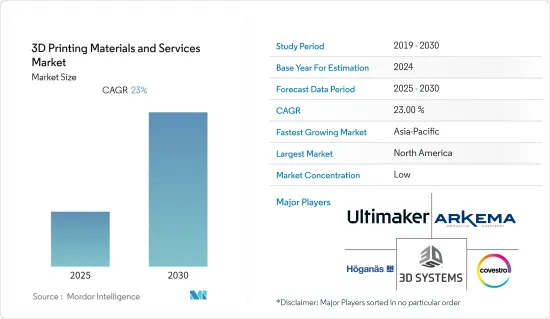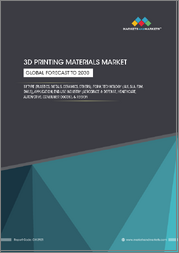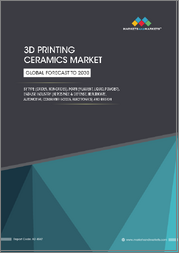
|
시장보고서
상품코드
1624574
세계의 3D 프린팅 재료 및 서비스 - 시장 점유율 분석, 산업 동향 및 통계, 성장 예측(2025-2030년)3D Printing Materials and Services - Market Share Analysis, Industry Trends & Statistics, Growth Forecasts (2025 - 2030) |
||||||
3D 프린팅 재료 및 서비스 시장은 예측 기간 동안 CAGR 23%를 나타낼 것으로 예상됩니다.

주요 하이라이트
- 3D 프린팅 기술의 초기 도입자 중 하나는 항공기 산업으로, 이 기술은 설계자에게 비용 절감과 생산 타당성에서 최고의 부품을 만드는 이점을 제공함으로써 복잡한 부품을 제조하는 데 유용합니다. 이 산업은 주로 제조 시 우수한 기계적 특성과 높은 치수 정확도를 제공하는 티타늄 금속 및 합금을 사용합니다.
- 교육 분야 수요 증가도 시장 성장을 가속하고 있습니다. 예를 들어, 많은 교육 기관에서 3D 프린팅을 위한 실험실을 설치하여 공대생들이 프로토타입을 인쇄할 수 있도록 하고, 생물학 학생들이 장기의 단면을 연구할 수 있도록 하며, 그래픽 디자인 학생들이 자신의 작품을 3D 버전으로 제작할 수 있도록 하고 있습니다.
- 헬스케어 분야에서의 부양책도 시장 성장에 긍정적인 영향을 미칠 것으로 예상됩니다. 예를 들어, 수술 장비, 보철물 및 임플란트, 조직공학 제품과 같은 다양한 의료 제품은 3D 프린팅 기술을 통해 제조되고 있으며, 정형외과, 치과, 두개악안면 등 다른 분야에서도 사용되고 있습니다.
- 높은 순도와 구성에 대한 높은 기준을 요구하기 때문에 재료 비용이 높으며, 이는 시장이 직면한 주요 억제요인입니다.
- 팬데믹은 3D 프린팅 재료 시장에 부정적인 영향을 미쳤으며, 공급망 혼란으로 인한 원자재 지연 및 미도착, 자금 흐름 악화, 생산 라인의 노동력 감소 등으로 인해 항공우주 및 방위, 자동차, 건설 등의 산업이 제로 또는 부분적인 생산 능력으로 운영되는 결과를 초래했습니다. 했습니다.
3D 프린팅 재료 및 서비스 시장 동향
3D 프린팅 재료 및 서비스 시장 동향자동차 산업에서의 활용도 증가
- 3D 프린팅 재료는 자동차 산업에서 테스트용 스케일 모델을 제조하는 데 널리 사용됩니다. 또한 벨로우즈, 프론트 범퍼, 에어컨 덕트, 서스펜션 위시본, 대시 보드 인터페이스, 발전기 장착 브래킷, 배터리 커버 및 기타 부품에도 사용됩니다. 자동차 OEM 제조업체는 신속한 프로토타이핑을 위해 3D 프린팅 재료를 사용하고 있습니다.
- 저비용, 제조 시간 단축, 재료 낭비 감소 등 3D 프린팅 공정의 장점으로 인해 자동차 제조업체는 이 공정을 사용하고 있으며, AUDI, Rolls Royce, Porsche, Hackrod 등 세계 최대 자동차 제조업체 중 일부는 예비 부품 및 금속 시제품을 생산하기 위해 이러한 재료를 사용하고 있습니다. 예비 부품 및 금속 프로토타입 제작에 이러한 재료를 사용하고 있습니다.
- 현재 세계 자동차 생산의 둔화는 자동차 섬유에 대한 수요가 감소함에 따라 폴리 에스테르 단섬유 시장에 영향을 미치고 있습니다. 또한 중국과 같은 국가의 자동차 판매 둔화는 3D 프린팅 재료에 대한 수요를 더욱 방해할 것으로 예상됩니다.
- 전 세계적으로 코로나19는 자동차 부문에 심각한 영향을 미치고 있으며, OICA(국제자동차연맹)에 따르면 2020년 3분기 세계 자동차 생산량은 약 5,000만 대로 2019년 3분기 생산량인 약 6,500만 대에 비해 큰 폭으로 감소했습니다. 감소했습니다.
중국이 시장을 독점할 전망
- 중국은 새로운 기술과 건설 목적의 혁신적인 재료 사용 측면에서 가장 빠르게 성장하는 시장 중 하나입니다. 세계 건설 중심지로서 중국의 압도적인 역할로 인해 3D 콘크리트 프린팅 분야의 가속화된 발전은 주택에서 기념비까지 다양한 응용 분야에서 중국의 전통적인 건설 산업에 혁명을 가져올 가능성이 높습니다.
- 중국에서는 3D 프린팅 기술을 이용한 건물, 사무실, 교량 건설이 활발히 이루어지고 있습니다. 또한, 상하이에는 176개의 콘크리트 유닛으로 구성된 86피트 길이의 세계 최장 3D 프린팅 교량이 있습니다.
- 건설 분야에서의 3D 프린팅은 건물 개발자의 신뢰 부족, 기술 사용에 대한 적절한 규제 부재 등 몇 가지 제한이 있습니다. 그러나 새로운 기술과 그 이점에 대한 인식이 높아짐에 따라 조직과 개인은 비용 절감을 목표로 하는 경향이 증가하고 있습니다. 이는 중국의 3D 콘크리트 프린팅 시장 수요를 견인하고 있습니다.
- 중국은 세계 최대의 자동차 생산국입니다. 최근 몇 년동안 생산량이 감소하고 있지만 전기자동차 분야는 성장할 것으로 예상되며, 2020년 4월 중화인민공화국 재정부가 신형 전기자동차에 대한 재정 보조를 촉진하는 방법에 관한 통지를 발표했습니다. 이에 따르면 2021년 1월 1일부터 2022년 12월 31일까지 구매되는 신형 전기자동차는 자동차 구매세가 면제됩니다.
- 또한 3D 프린팅의 레이어 바이 레이어 증착 공정은 센서, 안테나 및 기타 기능성 전자 장치를 플라스틱 부품, 금속 표면, 심지어 유리 패널 및 세라믹 소재에 직접 인쇄할 수 있습니다.
3D 프린팅 재료 및 서비스 산업 개요
3D 프린팅 재료 및 서비스 산업 개요3D 프린팅 재료 및 서비스 시장에서 활동하는 기업들은 제품 차별화와 새로운 응용 분야에 적용할 수 있는 재료의 혁신을 위해 재료 연구개발에 집중하고 있습니다. 주요 시장 공급업체로는 3D Systems, Inc, Arkema Group, CRP Technology S.r.l., EnvisionTEC Inc, EOS GmbH Electro Optical Systems, General Electric Company, Hoganas AB, LPW Technology Ltd, Royal DSM, Hoganas AB, LPW Technology Ltd, Royal DSM N.V., Sandvik AB, Solvay, Stratasys Ltd, Ultimaker B.V. 등이 있습니다.
- 2021년 9월 - 3D Systems는 주얼리 제조를 혁신적으로 변화시키는 소재 포트폴리오에 VisiJet Wax Jewel Red를 추가했습니다. 이 소재는 주얼리 제조업체가 더 복잡하고 내구성이 뛰어난 패턴을 설계하고 제조할 수 있도록 지원하여 생산 효율을 높이고 폐기물을 줄일 수 있습니다.
- 2020년 9월 - DSM은 DSM Resins & Functional Materials 및(기타) 관련 사업 매각의 일환으로 DSM Additive Manufacturing을 Covestro AG에 총 16억 1,000만 유로에 매각하기로 합의했다고 발표했습니다. DSM Additive Manufacturing은 3D 프린팅 분야에서 우수한 성능의 재료와 심도 있는 응용 전문성을 제공하여 제조업체들이 제품 설계 방식을 재검토할 수 있도록 지원하는 회사입니다. 같은 날 DSM은 해당 사업을 중단 사업으로 재분류했습니다. 이번 거래의 완료는 반독점법 승인을 포함한 규제 당국의 승인에 따라 달라질 수 있습니다.
기타 혜택
- 엑셀 형식 시장 예측(ME) 시트
- 3개월간의 애널리스트 지원
목차
제1장 서론
- 조사의 전제조건과 시장 정의
- 조사 범위
제2장 조사 방법
제3장 시장 역학
- 시장 개요
- 업계의 매력 - Porter의 Five Forces 분석
- 신규 진출업체의 위협
- 바이어의 교섭력
- 공급 기업의 교섭력
- 대체품의 위협
- 경쟁 기업간 경쟁 관계
- 업계 밸류체인 분석
- COVID-19의 업계에 대한 영향 평가
- 시장 성장 촉진요인
- 시장 성장 억제요인
제4장 시장 세분화
- 재료별
- 플라스틱(폴리프로필렌, 기타 플라스틱 포함)
- 세라믹
- 금속
- 기타 재료
- 최종사용자 산업별
- 자동차
- 항공우주 및 방위
- 헬스케어
- 건축 및 아키텍처
- 기타 최종사용자 산업
- 지역별
- 북미
- 유럽
- 아시아태평양
- 라틴아메리카
- 중동 및 아프리카
제5장 경쟁 구도
- 기업 개요
- 3D Systems, Inc.
- Arkema Group
- CRP Technology S.r.l.
- EnvisionTEC Inc.
- EOS GmbH Electro Optical Systems
- General Electric Company
- Hoganas AB
- LPW Technology, Ltd
- Royal DSM N.V.
- Sandvik AB
- Solvay
- Stratasys Ltd
- Ultimaker B.V.
제6장 투자 분석
제7장 시장의 미래
LSH 25.01.15The 3D Printing Materials and Services Market is expected to register a CAGR of 23% during the forecast period.

Key Highlights
- One of the early adopters of 3D Printing Technology is the aircraft industry, where the technology is useful for producing complex parts by providing designers the advantage of creating the best parts with reduced cost and production feasibility. The industry mainly uses titanium metal and alloys as it offers good mechanical properties and high dimensional accuracy during production.
- The growing demand from the educational sector is also driving the growth of the market. With labs being set up at many educational institutions for 3D printing, such as for engineering students to enable them to print prototypes, for biology students to allow them to study cross-sections of organs, and graphic design students to work on 3D versions of their work.
- The push from the healthcare sector is also expected to impact the growth of the market positively. For instance, various medical products, such as surgical equipment, prosthetics & implants, and tissue engineering products, are manufactured through 3D printing technology and in other sector applications such as orthopedic, dental, and craniomaxillofacial, and more.
- The high material cost is the major restraint the market is facing due to high material costs owing to its higher standards of purity and composition required.
- The pandemic has negatively impacted the 3D Printing Materials market with the supply chain disruptions resulting in delays or non-delivery of raw materials, financial flows getting affected, and decrease of the workforce in the production line have resulted in industries such as aerospace & defense, automotive, construction, and others to operate at zero or partial capacities.
3D Printing Materials and Services Market Trends
Increasing Applications in the Automotive Industry
- 3D printing materials are extensively used in the automotive industry to manufacture scaled models for testing. They are also used for components, such as bellows, front bumper, air conditioning ducting, suspension wishbone, dashboard interface, alternator mounting bracket, battery cover, etc. Automotive OEM manufacturers are using 3D printing materials for rapid prototyping.
- Owing to the advantages of the 3D printing process, such as low cost, less manufacturing time, reduced material wastage, etc., automotive manufacturers are moving toward the usage of this process. Some of the largest automotive manufacturers in the world, such as AUDI, Rolls Royce, Porsche, Hackrod, and many others, are using these materials for manufacturing spare parts and metal prototypes.
- The current slowdown in global automotive production has affected the market for polyester staple fiber because of the decreased demand for automotive fibers. Additionally, the current slowdown in automotive sales in countries such as China is further expected to hinder the demand for 3D printing materials.
- The pandemic has severely impacted the automotive sector globally; according to OICA (International Organization of Motor Vehicle Manufacturers), global production of vehicles in the third quarter of 2020 was around 50 million, a significant decrease compared to the production in the third quarter of 2019, which was around 65 million.
China is Expected to Dominate the Market
- China is among the fastest-growing markets in terms of new technologies and the usage of innovative materials for construction purposes. With China's dominating role as a global construction center, the accelerated development in the 3D concrete printing sector is likely to revolutionize the traditional construction industry in the country, with applications ranging from residential buildings to monuments.
- The country is involved in the construction of buildings, offices, and bridges using 3D printing technology. Additionally, Shanghai is the home for the longest 3D-printed bridge, which is 86 feet in length in the world, consisting of 176 concrete units.
- There are a few limitations for 3D printing in the construction sector, such as lack of confidence from building developers and absence of proper regulations for the usage of this technology. However, with the increasing awareness regarding new technologies and their advantages, organizations and individuals are increasingly tending toward cost-saving alternatives. This, in turn, is driving the demand in the 3D concrete printing market in the country.
- China has the world's largest automotive market in terms of production. Although the production in the country declined in the past few years, the electric vehicles segment is expected to grow. In April 2020, the Ministry of Finance of the People's Republic of China issued a notice on ways to promote financial subsidies for new electric vehicles. It stated that new EVs purchased between January 1, 2021, and December 31, 2022 would be exempted from vehicle purchase tax.
- Furthermore, the layer-by-layer deposition process in 3D printing allows sensors, antennas, and other functional electronics to be printed directly onto plastic components, metal surfaces, and even glass panels and ceramic materials.
3D Printing Materials and Services Industry Overview
Companies operating in 3D Printing Materials and Services Market focus on the research and development of its materials for product differentiation and innovation in materials that could be applied for newer applications areas. The key market vendors include 3D Systems, Inc., Arkema Group, CRP Technology S.r.l., EnvisionTEC Inc., EOS GmbH Electro Optical Systems, General Electric Company, Hoganas AB, LPW Technology Ltd, Royal DSM N.V., Sandvik AB, Solvay, Stratasys Ltd, and Ultimaker B.V.
- September 2021 - 3D Systems introduced VisiJet Wax Jewel Red, an addition to the materials portfolio that is transforming jewelry production. The material enables jewelry manufacturers to design and produce more intricate, durable patterns as well as deliver improved production efficiency and reduced waste.
- September 2020 - DSM announced an agreement to sell DSM additive manufacturing to Covestro AG at the total purchase price of EUR 1.61 billion, as part of the sale of DSM Resins & Functional Materials and (other) related businesses. DSM Additive Manufacturing provides performance materials and deep application expertise in 3D printing to help manufacturers rethink the way they design products. As of that date, DSM reclassified these businesses as discontinued operations. The closing of the transaction is subject to regulatory approvals, including antitrust clearance.
Additional Benefits:
- The market estimate (ME) sheet in Excel format
- 3 months of analyst support
TABLE OF CONTENTS
1 INTRODUCTION
- 1.1 Study Assumptions and Market Definition
- 1.2 Scope of the Study
2 RESEARCH METHODOLOGY
3 MARKET DYNAMICS
- 3.1 Market Overview
- 3.2 Industry Attractiveness - Porter's Five Forces Analysis
- 3.2.1 Threat of New Entrants
- 3.2.2 Bargaining Power of Buyers
- 3.2.3 Bargaining Power of Suppliers
- 3.2.4 Threat of Substitutes
- 3.2.5 Intensity of Competitive Rivalry
- 3.3 Industry Value Chain Analysis
- 3.4 Assessment of Impact of COVID-19 on the Industry
- 3.5 Market Drivers
- 3.5.1 Growing Usage in Manufacturing Applications
- 3.5.2 Mass Customization Associated with 3D Printing
- 3.5.3 Government Support for Research and Development
- 3.6 Market Restraints
- 3.6.1 High Capital Investment Requirement
4 MARKET SEGMENTATION
- 4.1 By Material
- 4.1.1 Plastics (including Polypropylene and other plastics)
- 4.1.2 Ceramics
- 4.1.3 Metals
- 4.1.4 Other Material Types
- 4.2 By End-user Industry
- 4.2.1 Automotive
- 4.2.2 Aerospace and Defense
- 4.2.3 Healthcare
- 4.2.4 Construction and Architecture
- 4.2.5 Other End-user Industries
- 4.3 By Geography
- 4.3.1 North America
- 4.3.2 Europe
- 4.3.3 Asia Pacific
- 4.3.4 Latin America
- 4.3.5 Middle East and Africa
5 COMPETITIVE LANDSCAPE
- 5.1 Company Profiles
- 5.1.1 3D Systems, Inc.
- 5.1.2 Arkema Group
- 5.1.3 CRP Technology S.r.l.
- 5.1.4 EnvisionTEC Inc.
- 5.1.5 EOS GmbH Electro Optical Systems
- 5.1.6 General Electric Company
- 5.1.7 Hoganas AB
- 5.1.8 LPW Technology, Ltd
- 5.1.9 Royal DSM N.V.
- 5.1.10 Sandvik AB
- 5.1.11 Solvay
- 5.1.12 Stratasys Ltd
- 5.1.13 Ultimaker B.V.



















